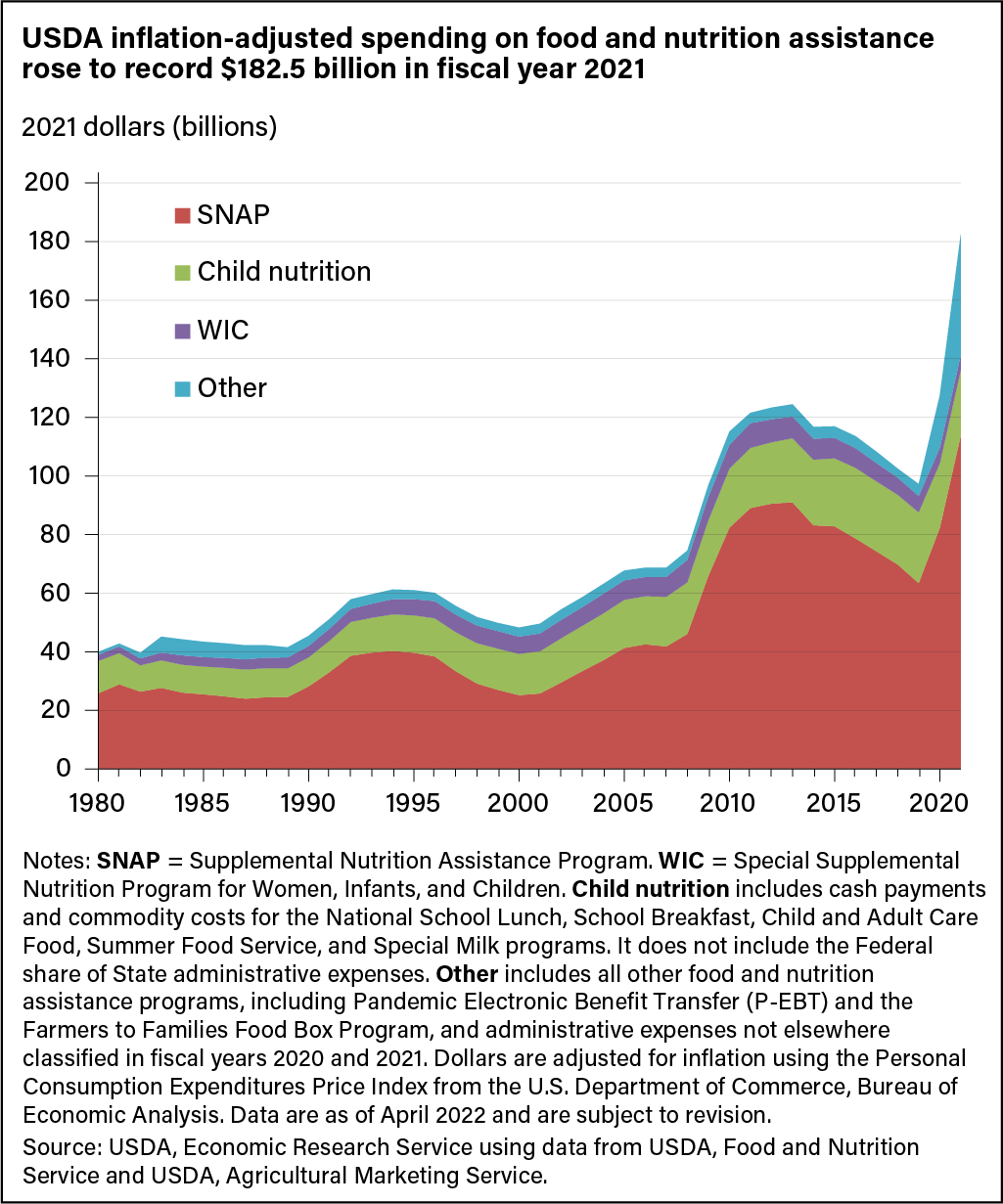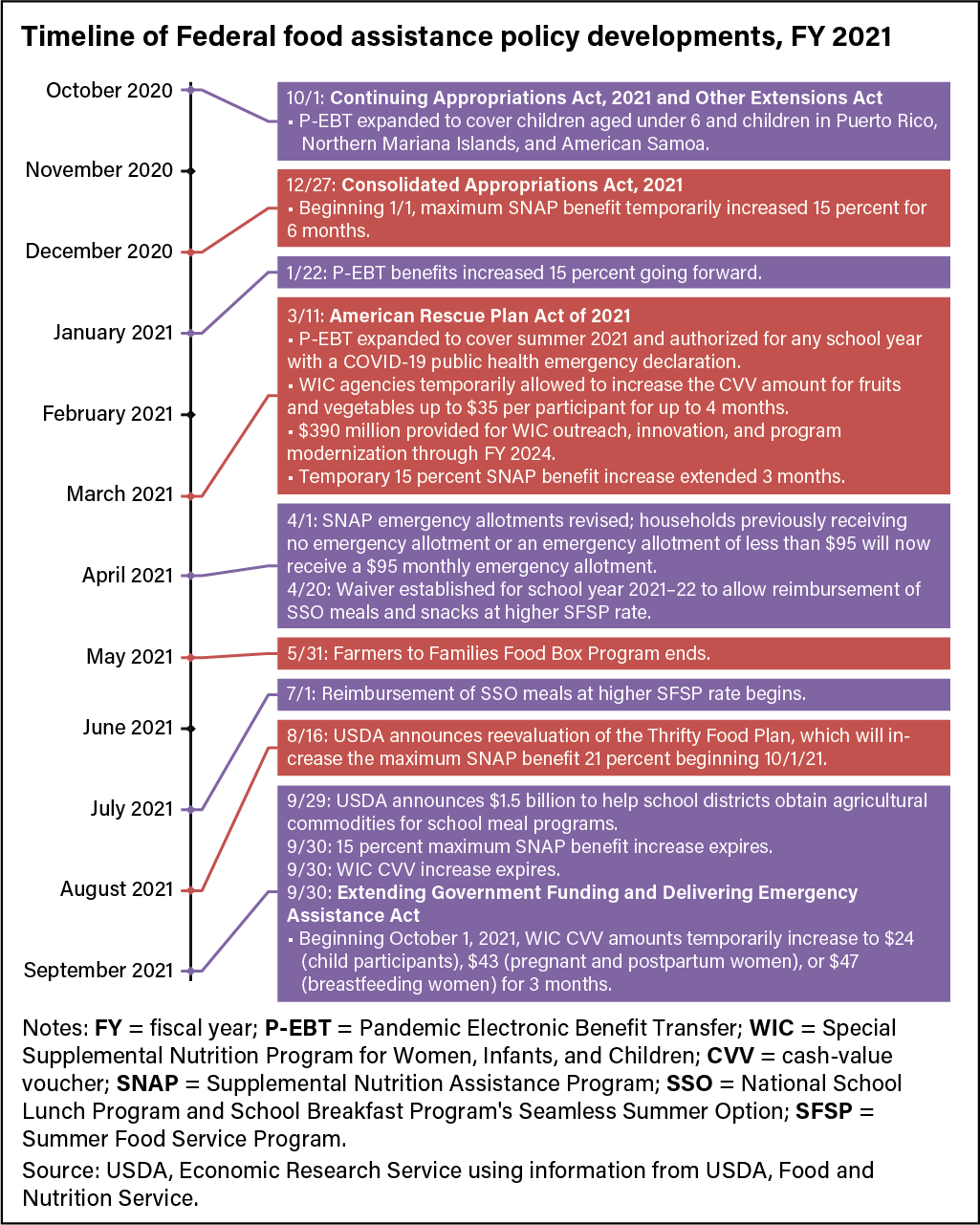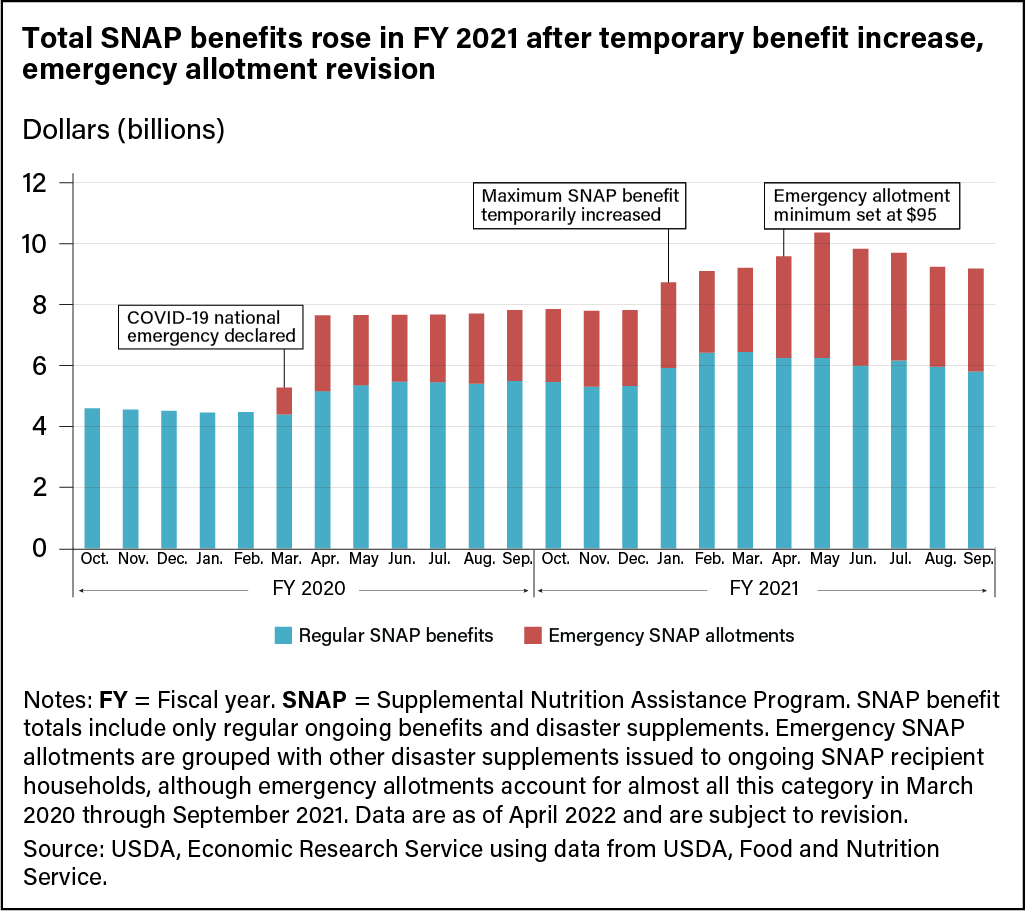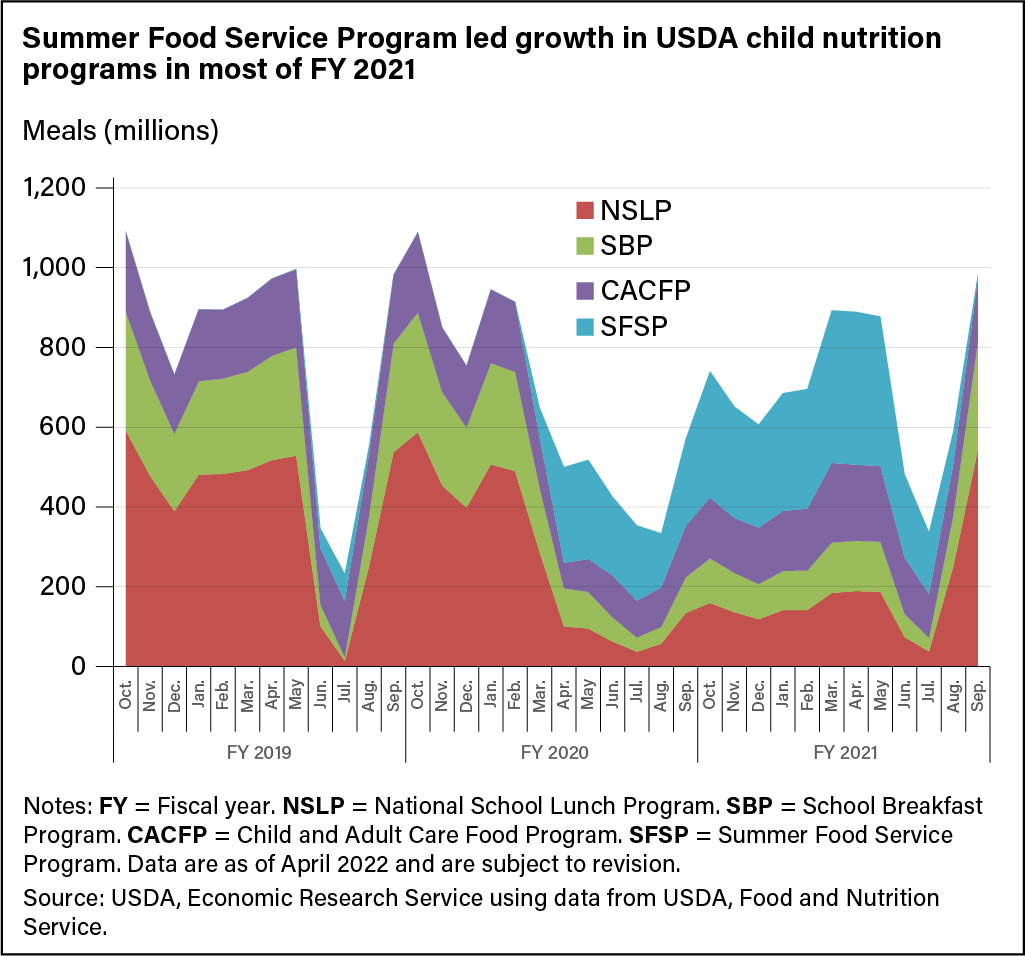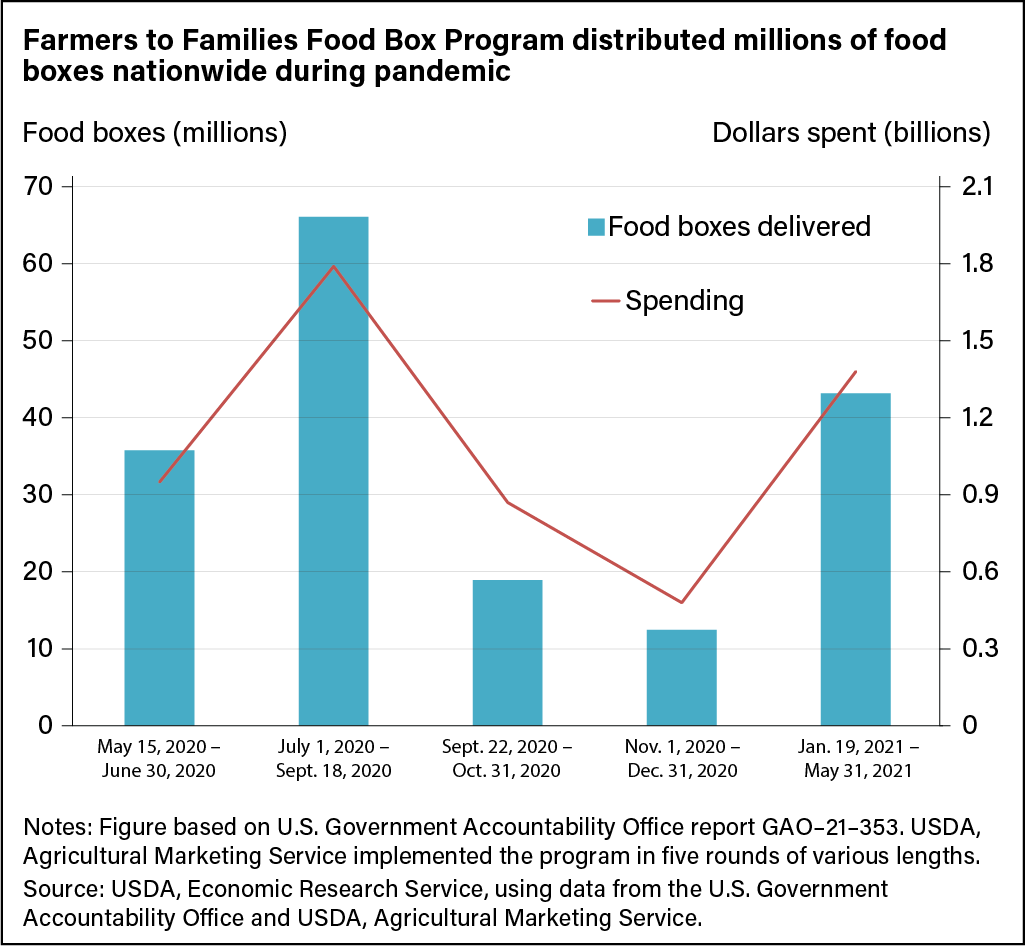
Pandemic-Related Program Changes Continued to Shape the U.S. Food and Nutrition Assistance Landscape in Fiscal Year 2021
- by Saied Toossi, Jordan W. Jones and Leslie Hodges
- 9/6/2022
Highlights
- The COVID-19 pandemic led to significant changes to existing USDA food and nutrition assistance programs and the creation of two temporary food assistance programs.
- USDA’s continued response to the pandemic in fiscal year (FY) 2021 (October 2020 through September 2021) pushed expenditures on food and nutrition assistance to a historic high of $182.5 billion for the second year in a row.
- The U.S. food and nutrition assistance landscape continued to evolve in FY 2022 with further pandemic-related adjustments to Federal programs.
The Coronavirus (COVID-19) pandemic led to an economic downturn and rising unemployment in fiscal year (FY) 2020 (October 1, 2019, to September 30, 2020), resulting in an increased need for food and nutrition assistance. In response, the U.S. Government expanded USDA’s food and nutrition assistance programs, adjusted program operations, and created additional, temporary programs. Throughout FY 2021 (October 1, 2020, to September 30, 2021), the Government continued to develop its food and nutrition assistance policy as the pandemic and its impacts persisted. Accordingly, annual USDA food and nutrition assistance spending nearly doubled from $92.5 billion in FY 2019 to a record $182.5 billion in FY 2021.
Researchers at USDA, Economic Research Service (ERS) document trends in food and nutrition assistance program participation and spending each fiscal year using data collected by USDA’s Food and Nutrition Service and Agricultural Marketing Service. ERS’s latest Food and Nutrition Assistance Landscape report describes participation and spending in USDA’s largest food and nutrition assistance programs during FY 2021, the first full fiscal year of the pandemic. The report documents how the Federal food assistance landscape continued to evolve in response to Federal legislation and economic conditions.
In both FY 2020 and FY 2021, changes to existing food and nutrition programs included increased benefits, expanded coverage, and ways to make program administration more flexible. In addition, Congress authorized USDA to create the Pandemic Electronic Benefit Transfer (P-EBT) program, which reimburses eligible families for the value of school meals their children miss because of the pandemic. USDA also created the Farmers to Families Food Box Program (Food Box Program), now expired, which facilitated the delivery of U.S. agricultural commodities to food banks and other charitable organizations.
A Look at Food and Nutrition Assistance and Relevant Legislation in FY 2020 and FY 2021
Typically, the largest food and nutrition assistance programs administered by USDA include the:
- Supplemental Nutrition Assistance Program (SNAP),
- Special Supplemental Nutrition Program for Women, Infants, and Children (WIC),
- National School Lunch Program (NSLP),
- School Breakfast Program (SBP), and
- Child and Adult Care Food Program (CACFP).
The largest program is SNAP, which provides low-income households with resources to buy food and reaches tens of millions of people each month. WIC provides supplemental food packages and other support to pregnant and postpartum women as well as infants and children up to age 5 who are at nutritional risk and living in low-income households. USDA’s child nutrition programs, including NSLP, SBP, and CACFP, provide nutritious meals and snacks at low or no cost to children in participating schools and childcare providers (and some adults in day care facilities through the CACFP).
In response to the pandemic, Congress passed two bills in March 2020 that transformed the food and nutrition assistance landscape. The Families First Coronavirus Response Act authorized SNAP emergency allotments to temporarily raise SNAP benefits, increased WIC appropriations, and gave USDA authority to launch P-EBT and the Food Box Program. The bill also authorized USDA to waive certain program requirements to support access to benefits while allowing for social distancing. The Coronavirus Aid, Relief, and Economic Security Act (known as the CARES Act) provided about $8.8 billion in additional funding for the child nutrition programs and an additional $15.8 billion for SNAP.
In FY 2021, two additional Federal spending bills also addressed nutrition assistance programs. One, which passed in October 2020, expanded P-EBT to cover more children, and another, passed in December 2020, temporarily increased maximum SNAP benefit levels. In March 2021, Congress passed the American Rescue Plan Act, which authorized P-EBT to cover the summer months, provided additional funding for WIC, and extended the temporary SNAP benefit increase through September 2021. (For a timeline of Federal legislative activity, see the graphic below.)
SNAP Benefits Continued to Rise in FY 2021
In FY 2019 and the first half of FY 2020 leading up to the pandemic, the number of SNAP participants and Federal spending for SNAP benefits continued a steady decline from the Great Recession-induced peaks of FY 2013. From October 2019 through February 2020, average monthly participation had fallen to 37.3 million and monthly benefits averaged $4.5 billion (including only regular ongoing benefits and disaster supplements).
The Families First Coronavirus Response Act increased SNAP benefits for those households not already receiving the maximum benefit—roughly 60 percent of households—through monthly emergency allotments. Regular SNAP benefits are determined based on household size and net income. Emergency allotments supplemented these benefits by providing all SNAP households with the maximum benefit amount for their household size, regardless of income. USDA also suspended work-related time limits on receiving SNAP benefits. These policy changes along with increased eligibility related to the economic downturn led to increases in the amount of monthly benefits issued. Total SNAP benefits increased from $4.5 billion in February 2020 to $7.7 billion in June 2020. SNAP participation also increased, peaking at 43.0 million in June 2020.
Spending on benefits remained at about the same level through the first 3 months of FY 2021 (October through December). A temporary 15-percent increase in the maximum SNAP benefit began in January 2021 and remained in effect through the end of FY 2021. Following this increase, total benefits grew to $8.7 billion in January 2021 from $7.8 billion a month earlier.
Benefits increased further in April 2021 when USDA revised emergency allotments to provide all participating households with a minimum monthly supplement of $95, increasing benefits of those previously receiving the regular maximum benefit or close to it. Total benefits peaked at $10.4 billion in May 2021, dropping off afterward. Overall, SNAP spending increased to a record $113.8 billion in FY 2021, 44 percent more than in FY 2020.
Total Meals Served Through USDA’s Child Nutrition Programs Rebounded in FY 2021
Disruptions for schools and childcare providers hindered the distribution of meals through the National School Lunch Program, the School Breakfast Program, and the Child and Adult Care Food Program, especially early in the pandemic. The Families First Coronavirus Response Act allowed USDA to adjust program operations to meet rising food needs. Subsequent legislation provided funding to support these adjustments. One set of waivers suspended requirements that meals be served in group settings at specific times and instead allowed for “grab and go” meals that children’s parents or guardians could pick up at schools or other locations.
Other waivers expanded the scope and coverage of the Summer Food Service Program (SFSP) and the NSLP and SBP’s Seamless Summer Option (SSO). Typically, these programs allow qualifying organizations to provide free meals to children when schools are not in session in areas or sites where at least half of children live in households with income less than 185 percent of the Federal poverty level. USDA waived these requirements, allowing the provision of free meals in all areas, regardless of income, throughout the latter half of FY 2020 and all of FY 2021. Beginning in July 2021, USDA also temporarily raised the amount by which it reimbursed organizations providing meals through the SSO. Under the change, the cost of meals served through the SSO would be reimbursed at the higher rate received by organizations serving meals through the SFSP.
Before the pandemic, most meals were served through the largest child nutrition programs during the school year in the months of August through May. Fewer meals were served over the summer months of June and July when most schools are closed for instruction. This pattern also held during the pandemic, but more meals were served in June and July in FY 2020 and FY 2021, compared with the same months in FY 2019.
While most meals were served through the NSLP, SBP, and CACFP before the pandemic, the child food and nutrition assistance safety net pivoted toward providing meals through summer meal programs beginning in March 2020. From April 2020 through June 2021, the Summer Food Service Program served more meals than any of the other programs. As schools transitioned to serving meals through the SSO in July 2021, the number of meals served under the NSLP and SBP rebounded to near pre-pandemic levels beginning in September 2021.
The number of meals served through the NSLP, SBP, CACFP, and SFSP combined increased to 8.4 billion in FY 2021 from 7.9 billion in FY 2020, but it was still fewer than the 9.5 billion total meals served in FY 2019. However, total spending on the four programs rose to $26.8 billion in FY 2021, up from $21.2 billion in FY 2020 and $23 billion in FY 2019. The increase in spending was driven by the greater number of Summer Food Service Program meals served in FY 2021, which were reimbursed at higher rates than NSLP and SBP meals, and by an increase in SSO meals after July 2021.
More Children Participated in WIC in FY 2021
Throughout FY 2021, State WIC agencies continued to use waivers issued in FY 2020 to offer flexibilities to enable participants’ continued access to WIC services. Waivers allowed for alternative modes of service delivery (such as remote certification and recertification), deferrals of medical documentation requirements for applicants, and food package substitutions necessary because of food shortages. WIC food benefits include a cash-value voucher, which is a fixed dollar amount that can be used to buy a variety of fruits and vegetables. Under the American Rescue Plan Act, WIC State agencies could increase the cash-value voucher amount for fruit and vegetable purchases from $9 for adults and $11 for children to a maximum of $35 per participant for up to 4 months through September 30, 2021. All State agencies elected to increase the cash-value voucher to $35 and most did so between June and September 2021.
Unlike USDA’s other food and nutrition assistance programs, WIC did not see substantial changes in participation over the course of the pandemic. Overall, WIC served an average of 6.2 million participants per month in FY 2021, about the same as in FY 2020 and down from 6.4 million in FY 2019.
Trends in participation varied across groups eligible for WIC. The number of women and infants participating trended downward from FY 2019 through FY 2021, consistent with declines in the number of U.S. births over the same period. On the other hand, the number of children up to age 5 participating in WIC rose in FY 2021. Child participation trended downward from the early months of FY 2019 through February 2020, much like trends for infant and women participants. However, child participation began to increase in March 2020 with the onset of the pandemic, continued to rise through October 2020, and remained steady (around 3.4 million children a month) from October 2020 through September 2021.
Trends in USDA spending on WIC food benefit redemptions also differed from trends in spending for USDA’s other food and nutrition assistance programs. Monthly WIC food costs decreased from $262 million in FY 2019 to $240 million in FY 2020, and further declined to $221 million in FY 2021.
Temporary Programs Continued to Operate in FY 2021
In 2020, the Families First Coronavirus Response Act authorized the P-EBT program to reimburse eligible families for the value of school meals missed because of pandemic-related disruptions to school operations. States proposed plans to provide P-EBT benefits on different timelines, which USDA then approved. Benefit distribution schedules also differed as some States issued benefits in a lump sum to cover an entire period of missed meals while others issued multiple smaller payments.
The Federal Government expanded P-EBT several times in FY 2021. In October 2020, P-EBT was expanded to include eligible children under age 6 and to operate in Puerto Rico, the Northern Mariana Islands, and American Samoa. In January 2021, the program’s benefits were increased by about 15 percent to include the value of school snacks. In March 2021, the American Rescue Plan Act authorized the P-EBT program for summer 2021 and any future school year with a COVID-19 public health emergency declaration in place. Overall, the Federal Government spent a total of about $39.1 billion on P-EBT in FY 2020 and FY 2021.
The pandemic also disrupted the food supply chain and changed consumer behavior. To support the agricultural industry as well as families in need, the Families First Coronavirus Response Act granted USDA authority to create the Food Box Program. Through the program, USDA bought boxes of produce, dairy products, meat, and other agricultural commodities for delivery to food banks and other charitable organizations. The program launched in May 2020 and was allowed to expire in May 2021. Over the course of its operation, the program distributed 176.4 million food boxes at a cost of $5.5 billion.
USDA’s Domestic Food and Nutrition Assistance Programs Continued to Change Beyond FY 2021
In response to the ongoing pandemic, legislative and policy changes to U.S. food and nutrition assistance programs continued into FY 2022. The temporary increase in SNAP benefits expired in September 2021 but was replaced with a permanent 21-percent increase beginning in October 2021 after a reevaluation of the Thrifty Food Plan on which benefit amounts are based. As some did in FY 2021, States continued to end SNAP emergency allotments. The WIC cash-value voucher increase expired at the end of FY 2021 but was temporarily replaced with an increase to $24 for child participants, $43 for pregnant and postpartum women, and $47 for breastfeeding women beginning October 2021 and continuing through September 2022. USDA also announced $2.5 billion in aid to help school districts obtain food and supplies as pandemic-related supply chain disruptions continued to hamper the meal provision of schools, and Federal legislation in June 2022 temporarily extended some child nutrition waivers, which were set to expire at the end of that month. ERS researchers will continue to track how these and other developments, such as rising food costs, affect the domestic food and nutrition assistance landscape.
This article is drawn from:
- Jones, J.W., Toossi, S. & Hodges, L. (2022). The Food and Nutrition Assistance Landscape: Fiscal Year 2021 Annual Report. U.S. Department of Agriculture, Economic Research Service. EIB-237.
You may also like:
- Hodges, L., Jones, J.W. & Toossi, S. (2021, October 4). Coronavirus (COVID-19) Pandemic Transformed the U.S. Federal Food and Nutrition Assistance Landscape . Amber Waves, U.S. Department of Agriculture, Economic Research Service.
- Toossi, S., Jones, J.W. & Hodges, L. (2021). The Food and Nutrition Assistance Landscape: Fiscal Year 2020 Annual Report. U.S. Department of Agriculture, Economic Research Service. EIB-227.
- Jones, J.W. (2021). COVID-19 Working Paper: Supplemental Nutrition Assistance Program and Pandemic Electronic Benefit Transfer Redemptions during the Coronavirus Pandemic. U.S. Department of Agriculture, Economic Research Service. AP-089.
- Toossi, S. (2021). COVID-19 Working Paper: Filling the Pandemic Meal Gap: Disruptions to Child Nutrition Programs and Expansion of Free Meal Sites in the Early Months of the Pandemic. U.S. Department of Agriculture, Economic Research Service. AP-093.


